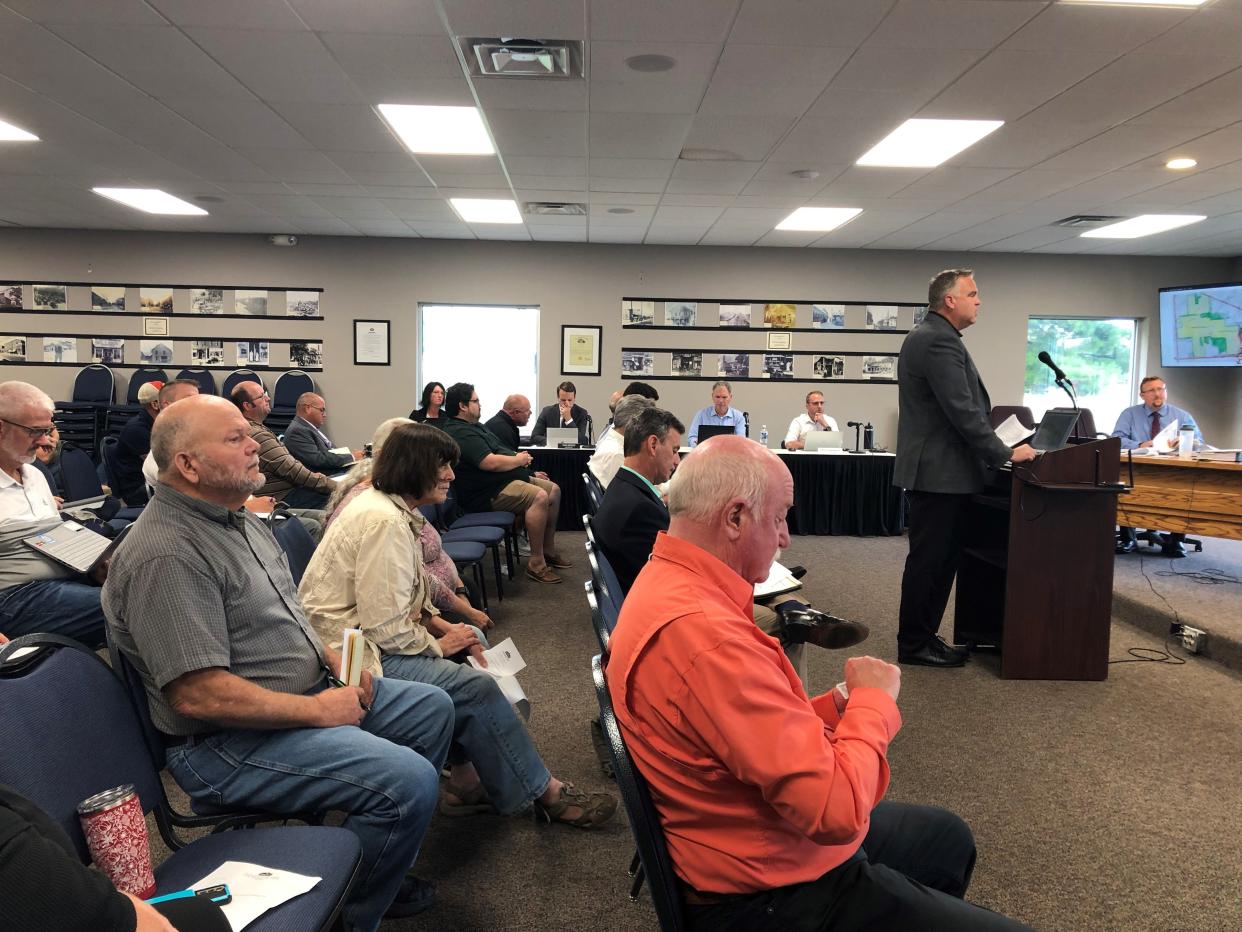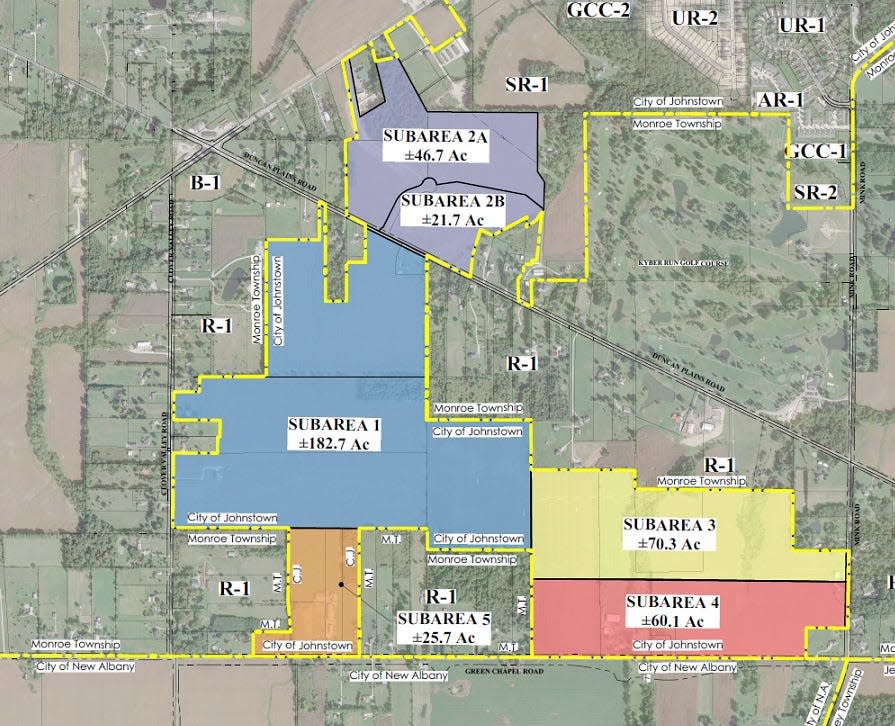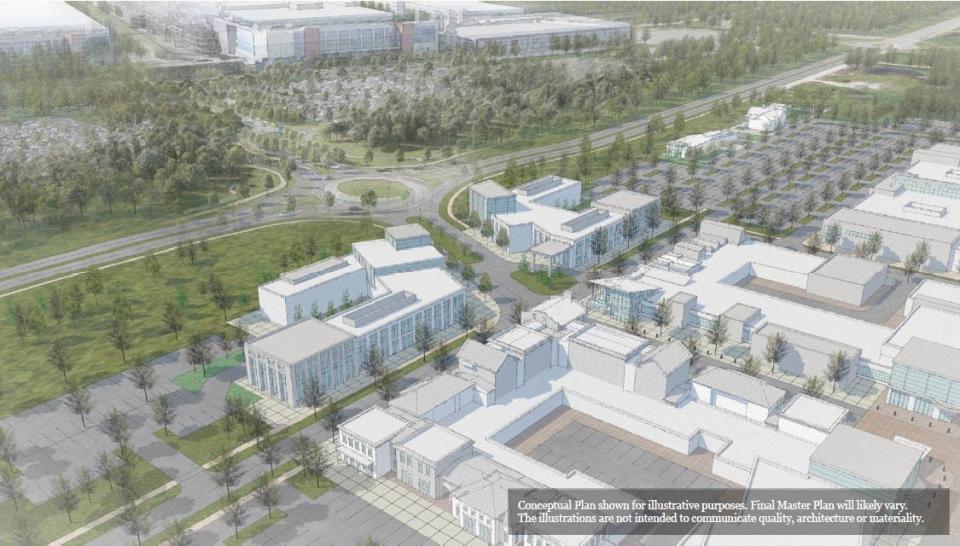'We're not New Albany': Johnstown area-residents speak out against 407-acre development

Johnstown is considering a massive 407-acre, mixed-use development that could bring manufacturing, commercial, office spaces, retail, park space, housing and more to the Licking County community. But residents fear the rural area could turn into another New Albany.
After sharing the initial development concept last month, officials with The New Albany Co. returned Tuesday to the Johnstown Planning Commission to share more details about the tentatively named Johnstown Gateway Planned District, a mixed-use development just north of the Intel site. Originally expected to be 417 acres, the now 407-acre development area is bordered by Green Chapel to the south, Clover Valley to the west, Mink Street to the east and north of Duncan Plains to the north.
As previously reported, the site includes 286 recently annexed acres and 131 acres already in the city. The proposed development is divided into five areas and allows for manufacturing, commercial, data centers, office, warehouse, parking structures, retail, park land and potentially more than 1,000 housing units.
Aaron Underhill, an attorney for land use and development for The New Albany Co., said Johnstown is at the precipice of a significant opportunity for area residents to have jobs for generations to come.
He said he understands the mix of emotions residents might feel; the optimism about a once in a lifetime opportunity; and the skepticism that the promises and predictions might be too good to be true.
"The land we're talking about tonight is one of the most uniquely positioned in the entire country. An ecosystem of suppliers, businesses and mixed use development is more than just appropriate at this location. It is necessary and essential to support the Intel campus."
Johnstown has the opportunity to control that development by creating a cohesive plan rather than having disjointed development.
But residents who spoke fear Johnstown could become an extension of New Albany, which is not what they want.
A sentiment expressed by 25-year Liberty Township resident Molly Gamertsfelder — and shared by others — is that the majority of people are not happy with what's happening in the area.
"We're Johnstown; we're not New Albany. If we're going to grow, we want to grow and be an individual. We want Johnstown to be a cool town. A cool place to live," she said. "Not just a sprawling conglomerate of businesses, restaurants, what have you. Not that we can't have some, but the general perspective is 'Oh, God; it's just going be a mess.'"
Manon VanSchoyck, another long-time resident, said she moved to Johnstown area from Dublin because she wanted to get away from the city. She appreciates seeing wildlife close by and seeing the stars in the night sky. A development like the one proposed is too similar to that of a city and doesn't appeal to her or other local residents, she said.
"If I wanted that type of living, I would live there," she said.
What could be included in the Johnstown development?

Subarea 1 is 182.7 acres and has frontage on Clover Valley and Duncan Plains road. Permitted uses would include office, major institutional, manufacturing, production and industrial, data centers, warehousing and park land.
"It would not allow other things unless they were sort of in a supporting role … like having a Starbucks in an office building for instance, but you wouldn't see a standalone Starbucks in this subarea," Underhill said.
The 21-acre Subarea 2 is north of Duncan Plains Road, just east of U.S. 62, and it would have similar uses as Subarea 1, he said.
Subarea 3 comprises 70 acres between Green Chapel and Duncan Plains roads with frontage on Mink Street. Underhill said it's the only subarea where a pure multifamily project would be permitted. The development plan proposes a total of three housing units per acre of multifamily residential. The subarea would also allow for community institutional, neighborhood commercial, mixed-use, parking structures and park land.
For the 60-acre Subarea 4, which is just south of Subarea 3, mixed use would be required. To qualify for mixed use, a plan with multifamily residential would also need to include space for up to two other uses to ensure other uses such as restaurants, small office space and others are included.

Jamie McNally, director of real estate sales for The New Albany Co., said the apartments built in Subarea 4 would target the 22- to 35-year-old young professionals working at Intel. He said he expects the apartments would be about 600-700 square feet.
Underhill said the company understands the concerns about the enrollment capacity of Johnstown-Monroe Local Schools. He said according to data from the developer of Bridge Park, a mixed-use development in Dublin, 13 students live within the development's roughly 700 rental units.
They also looked into Grandview Yard, a neighborhood with residential, businesses, restaurants and more in Grandview, and 22 school-age children live in the area's 1,300 rental units.
Johnstown-Monroe Superintendent Philip Wagner said the school district met with The New Albany Co. once so far and will meet with them in the future about this proposed development. The district has long-range planning for student enrollment, and district officials are reviewing this development to determine the impact on enrollment.
For the 25-acre Subarea 5, Underhill said The New Albany Co. is proposing a choice of use to the city. It could be an extension of Subarea 1 or 4. "We think over time the market is going to tell us which direction that needs to go in," he said.
What happens next with the proposal?
The planning commission will again discuss the proposal at its next meeting, Sept. 26, and Commission Chairman Ryan Green said after the meeting the commission will continue to go through every aspect of the plan.
The commission will either recommend approval or denial of the project to Johnstown City Council, which has the final say on whether the development will move forward.
Green said there is no set date on when the planning commission will make its recommendation.
"These things are application and information driven. There's a process that we go through and we want to make sure that we're thorough and thoughtful," he said.
The city will also host a meeting at 6 p.m. Sept. 27 in council chambers about updates to its comprehensive plan, on which the city has been working for the past year. Chris Hermann, a planner with the city's planning firm MKSK, said the meeting will cover the future of Johnstown and amenities, policies and direction residents want for the growing city.
mdevito@gannett.com
740-607-2175
Twitter: @MariaDeVito13
This article originally appeared on Newark Advocate: Johnstown area-residents speak out against 407-acre development

